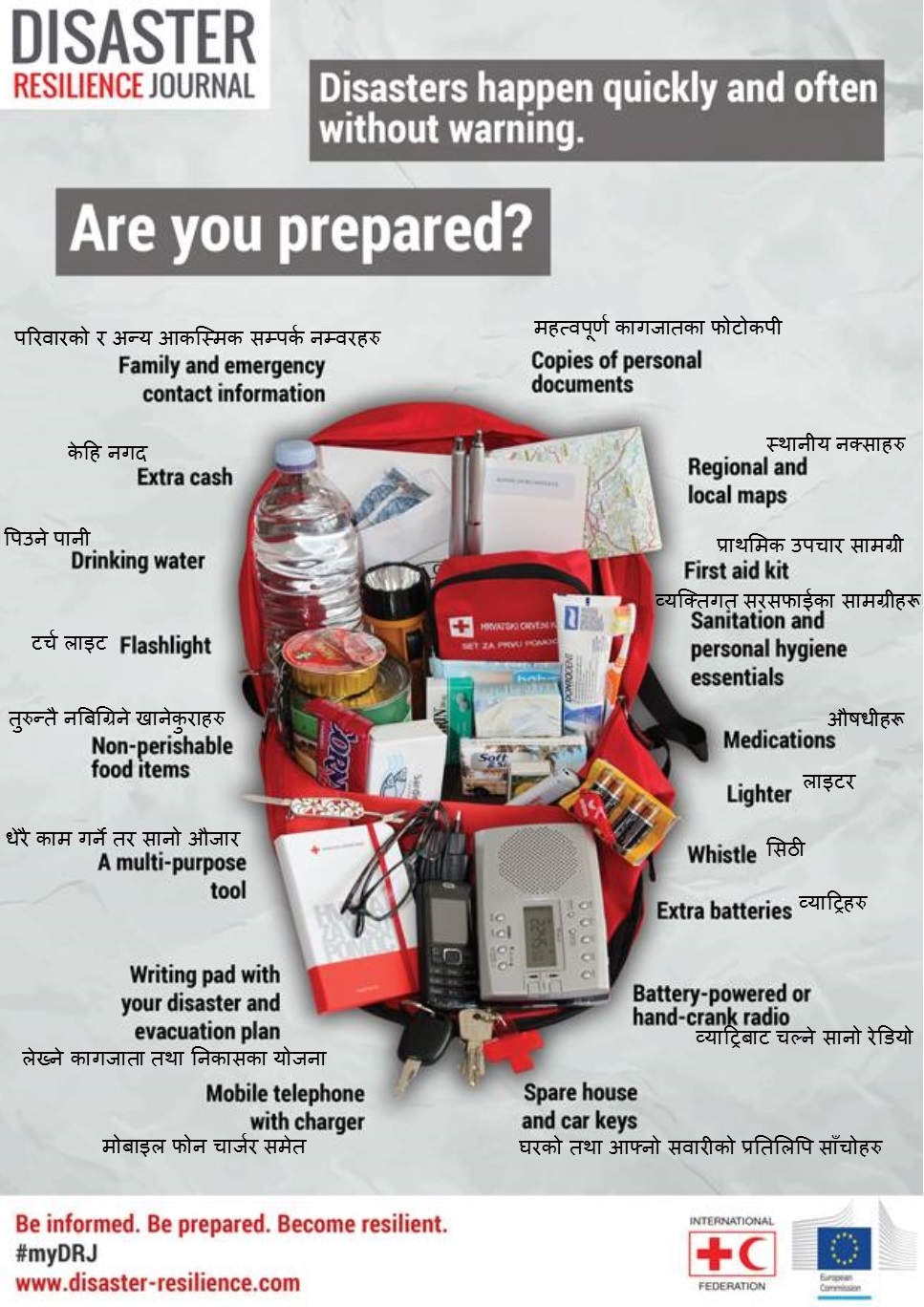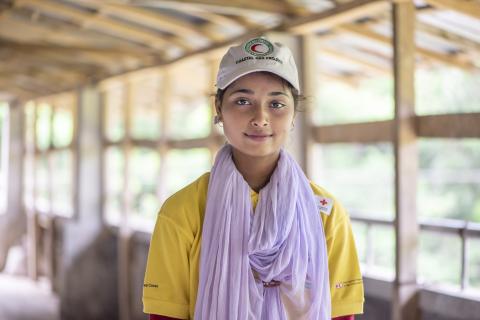Nepal earthquake: How a GO BAG (Emergency Kit) became the Bag for Survival

On April 25, 2015, an earthquake with a magnitude of over 7.8M killed more than 9,000 people and injured more than 23,000 in Nepal. This is the second story in a series which highlights preparedness measures taken by every day individuals before the earthquake struck.
Based on the interaction with Sita Shrestha, Thankot
“When the earthquake struck, I was with my small daughter (5 Month) in the top floor. My 6 years old son was downstairs. He started to cry but didn’t came up and asked “which one is the inner wall (safe place)?” and I said that the place where you are is the inner wall and he stayed there. I also stayed in the inner wall with my small daughter until the shaking stopped. As soon as the shaking stopped, I took my son and daughter out of the house along with our “Go Bag” (Emergency Kit named as Go Bag). We went out in courtyard, the nearby open space.
Since I had received training on earthquake preparedness and emergency response organized by NSET a couple of years ago, I told my children and other family member not to panic or use the staircase but stay at the safe place and go outside once the shaking stops. This worked for us. I had also learned about the need to store the emergency items in a kit from the training. I knew that the Go Bag was important and so kept one myself but I had not imagined that our GO-Bag could be so much useful under such chaotic circumstances.
All the items of my Go Bag like Dettol, “Piyush” (water purifier), tarpaulin, head lamp, toothpaste, and soap, etc. came to use. We used the tarpaulin for emergency shelter and stayed there. Dettol was used in cleaning the wounds of the children. Due to earthquake many people had headache and indigestion so I gave them the Cetamol and Digene from the Go Bag. We all were using the soap and toothpaste from the Bag. I had also kept Playing Cards in the Bag. The young boys who stayed awake during the nights, played cards to keep awake and keep the area safe as well.
So many houses had been destroyed due to the April 25 Earthquake. The single Go Bag I had stored had been so useful to many of us. I thought what if everyone had their own Go Bag? It would have been a lot easier in such devastating emergency situation. I strongly request everyone to learn and follow the safe behavior during earthquake and store an emergency kit- Go Bag in their house as well.”
Sita Shrestha from Thankot, Chadragiri Municipality got training on Disaster Risk Management from NSET in 2012 under Nepal Earthquake Risk Management Project (NERMP II). Thankot, Chandragiri Municipality is one the municipalities where NSET is implementing its Community Based Disaster Risk Management Program.
“गो ब्याग” जीवन बचाउने झोला
(थानकोट, चन्द्रागिरी नगरपालिका निवासी सीता श्रेष्ठसंगको कुराकानीमा आधारित)
भुकम्प जाँदा म पाँच महिनाकी सानी छोरीलाई लिएर माथिल्लो तल्लामा बसिरहेकी थिएँ। ६ वर्षको छोरो चाहिं तल्लो तल्लामा थियो। छोरो रून कराउन थाल्यो। ऊ माथि आएन बरू तलैबाट करायो, “कुन भित्ता भित्रि गार्हो हो र सुरक्षित छ?“ ऊ भित्रि गार्हो भएकै सुरक्षित ठाऊँमा थियो। त्यसैले मैले उसलाई त्यहिं बस्न भने। म पनि सानी छोरीलाई च्यापेर कम्पन नरोकीउन्जेल भित्रि गार्हो भएको सुरक्षित ठाऊँमा बासिरहें। कम्पन रोकिना साथ छोरा-छोरी दुबै र “गो ब्याग” (अत्यावश्क सामग्री भएको भुकम्प झट्पट झोला) समेत लिएर म घरबाट निस्कें र नजिकैको चोकमा गएँ।
मैले एनसेटको विपद् जोखिम व्यबस्थापन, भुकम्प पूर्वतयारी तथा आकस्मिक योजना सम्बन्धी तालिम केही वर्ष पहिला लिएको थिएँ। त्यसैकारण मैले मेरा छोराछोरी र परिवारका अन्य सदस्यहरूलाई भुकम्पको समयमा कुनै भ-याङ्को प्रयोग नगर्ने बरू नआत्तिकन सुरक्षित ठाँउमा बस्ने र कम्पन रोकिए पछि घरबाट निस्केर नजिकैको सुरक्षित खुला ठाँउमा जाने भनेर सिकाएको थिएँ। सबैले सोहि अनुसार गरे! मैले त्यसै तालिमबाट भुकम्प झट्पट झोला “गो ब्याग” मा अत्यावश्क सामग्रीहरू सञ्चित गर्नुपर्छ भन्ने पनि सिकेको थिएँ। मलाई “गो ब्याग” अत्यावश्यक चिज हो भन्ने थाहा थियो, त्यसैले मैले यो तयारी हालतमा राखेको थिएँ। तर मलाई यस्तो अस्तव्यस्तको समयमा हाम्रो यो “गो ब्याग”का यी सामग्रीहरूको समुयोचित प्रयोग होला भन्ने कल्पना पनि थिएन।
“गो ब्याग”का सामग्रीहरू डेटोल, पानी शुध्दिकरण गर्ने औषधी पियूस, टार्पोलिन, सिरमा राखेर बाल्ने बत्ति, दाँत माज्ने मञ्जन इत्यादी सबै प्रयोगमा आए। टार्पोलिनको प्रयोग गरी हामीले अस्थायी वासस्थान बनायौं। केटाकेटीका घाउ सफा गर्न डेटोलको प्रयोग भयो। भुकम्पबाट आत्तिएका कारण धेरैको टाउको दुख्ने र पाचन शक्ति कमजोर भएको थियो। त्यसैले मैले “गो ब्याग”मा भएका औषधीहरू सिटामोल र डाइजिन प्रयोग गर्न दिएँ। हामीले सबैले “गो ब्याग” भित्रका साबुन तथा मञ्जन प्रयोग गर्यौं। “गो ब्याग”मा मैले केही जोर तास पनि राखेको थिएँ। हाम्रो इलाका सुरक्षित राख्न राती नसुति बसेका युवाहरूलाई ती तास खेलेर समय कटाउन पनि सजिलै भयो।
वैशाख १२, २०७२ को भुकम्पले धेरै घर क्षति भए। तर एउटा “गो ब्याग” जुन मैले बनाएर राखेको थिएँ त्यसैले कत्तिलाई उपयोगी भयो। म सोच्दछु यदि सबैको आफ्नो आफ्नो “गो ब्याग” भएको भए पक्कै पनि अतिनै सजिलो हुन्थ्यो होला यस्तो अत्यावश्क अवस्थामा। म सबैलाई के अनुरोघ गर्छु भने कृपया भुकम्पको समयमा गर्नु पर्ने पूर्वतयारी तथा आकस्मिक योजना वारे बुझ्नु होस् र त्यसलाई समुयोचित प्रयोग गर्दै घर-घरमा “गो ब्याग” (अत्यावश्क सामग्री भएको भुकम्प झट्पट झोला) को ब्यवस्था गर्नुहोस्।
(थानकोट, चन्द्रागिरी नगरपालिका निवासी सीता श्रेष्ठले सन् २०१२ मा नेपाल भुकम्प विपद् व्यबस्थापन परियोजना अन्तरगत एनसेटको विपद् जोखिम व्यबस्थापन तालिम लिनुभएको थियो। थानकोट, चन्द्रागिरी नगरपालिका पनि एउटा नगरपालिका हो जसमा एनसेटले समुदायमा आधारित विपद् जोखिम न्यूनिकरण कार्यक्रम लागु गरेको छ।)

Lessons Learned :
- Every Nepali household should have a Go Bag ready to take with if evacuation is needed. Whether self-created, provided through training such as The Pillowcase Project, or through employers.
- Workplace trainings and institutional preparedness benefits individual and household preparedness and creates a culture of readiness in communities.
- Continue to keep your Go Bag up-to-date, and do not be discouraged if it goes unused.
- Practice evacuating after an earthquake, and grabbing your Go Bag on the way out

Photo courtesy of Red Cross-EU Office. Nepali text overlay by Amod Bhattarai.
Resources
1. The IFRC suggests the following to be included in a Go Bag:
- emergency water (one gallon per person, per day, 3-day supply for evacuation)
- high-energy food
- communication equipment such as a portable radio (solar wind up, or with extra batteries)
- first aid supplies and prescription medications
- tools including a torch/flashlight (solar, wind up or with extra batteries), multi-purpose tool, matches
- clothing, including rain gear, a change of underclothing, sturdy shoes and work gloves
- emergency blanket
- personal toiletries, medications, and items such as assistive devices
- emergency contact information and copies of vital records
- cash
2. Safe Steps Emergency Kit List
3. Safe Steps Emergency Kit Video (6 languages):
Supporting Materials :



